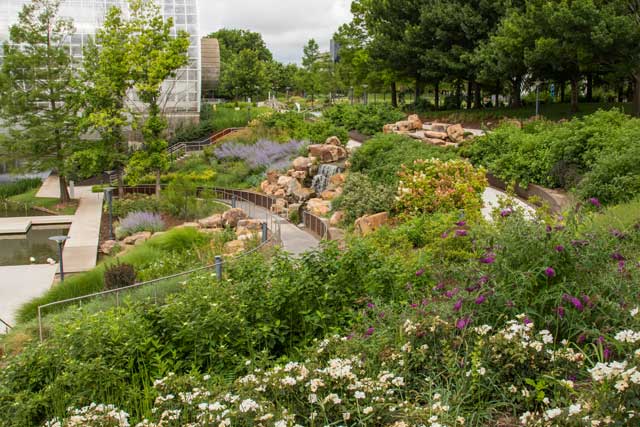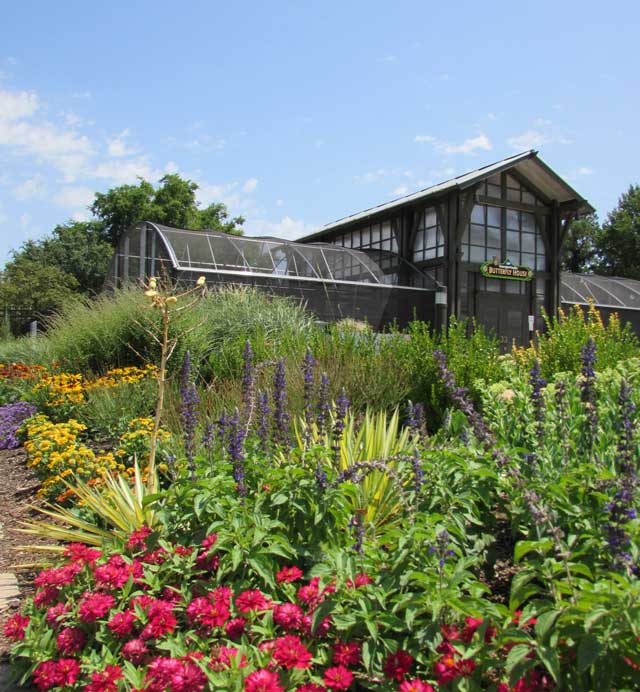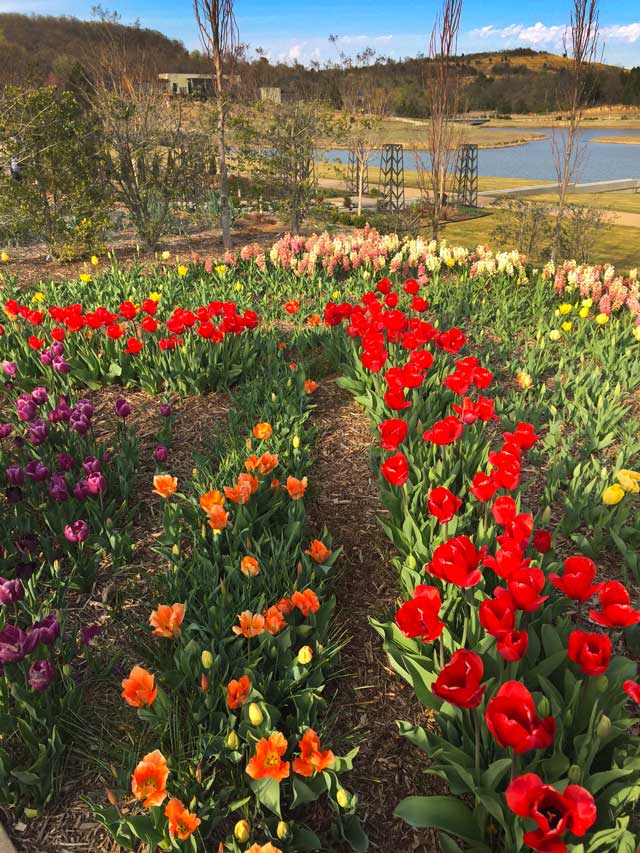
[dropcap]Whether[dropcap] you’re looking to learn more about the state’s native landscape or be wowed by unusual flora from around the country, Oklahoma’s botanical gardens provide perfect summer getaways.
Myriad Botanical Gardens
The lush landscape of Oklahoma City’s Myriad Botanical Gardens can come as a surprise to some.
“Because we are right in the middle of downtown, we always hear exclamations of ‘Oh, wow!’ when people walk in,” says Executive Director Maureen Heffernan. “People are often surprised to be greeted by such a beautiful oasis right here in the city.”
The garden first opened in 1988 and was run by the city government, but the grounds looked nothing like they do today. The garden’s major renovation took off about five years ago when Devon Energy began constructing its 50-story tower and enabled the funding for the project through tax increment financing (TIF). The Myriad Botanical Gardens is now a nonprofit.

Nearly $50 million was set aside for the garden’s renovations through the TIF funding, Heffernan says, which included a prairie garden.
“A designer came in and incorporated a lot of naturalistic effects, which came out wonderfully. The prairie garden includes native plants, grasses and all kinds of different flowers from part of the country,” Heffernan says. “It serves educational purposes too, because it gives visitors a sense of place and displays the true beauty of this natural region. We also have a lot of information about ways to help local pollinators.”
Through the renovations, the gardens were transformed to include several distinct expanses in addition to the prairie garden. Today, the 15-acre gardens include a dog park, a children’s garden, walking paths, an outdoor stage and more.
“We’re always working to improve and add new things. There truly is something for everyone here,” Heffernan says.
When planning a trip, Heffernan recommends checking out the events calendar on the Myriad Botanical Gardens website in advance.
“You might want to come at a specific time, since we have a lot of different things going on. We have yoga, swing dancing classes, children’s story times and ‘Weekly Walk-Ups’ activities, and special festivals,” Heffernan says.
Plant enthusiasts can also access the Garden Explorer plant database on their phones to learn interesting facts about each plant as they are exploring the grounds. The garden also includes the Crystal Bridge Conservatory, a popular wedding spot that features a varied collection of tropical and flowering plants.

The Papilion at Honor Heights Park
When the City of Muskogee’s Chamber of Commerce considered different ways of increasing tourism, one type seemed to fit the small town perfectly: agritourism.
“It just seemed like the perfect way to bring people to Muskogee, but they also wanted to do something different,” says Papilion Operations Manager Katherine Coburn.
The new idea resulted in the Butterfly House located in the large Honor Heights Park.
“We have between 200 and 300 butterflies here at all times in an open-air garden that is closed in like a greenhouse,” Coburn says. “We’re licensed to have over 200 varieties, so there are so many different ones to see every time you visit.”
The butterflies are actually shipped to the garden because if they are grown from eggs, caterpillars eat all the leaves, killing the plants that the grown butterflies need. Most of the insects are supplied from South Florida, Alabama and Texas.
“They come shipped in packages that look like thin, wax envelopes. They’re on ice because when butterflies get cold, they kind of hibernate in a sleeping state,” Coburn says. “When they arrive, it’s critical that they are released as soon as possible, and you can always recognize the new ones because they’re a little drowsy and disoriented at first. But they wake up soon and find the nectar plants and they’re happy!”
Coburn herself is new to the world of butterflies, having joined the garden staff two years ago, but she says her work with the insects has changed the way she looks at the world.
“I can be driving along, and I’ll just happen to notice a butterfly flying along,” she says. “I’ve learned a lot, and I keep learning new things from them every day. It’s a peaceful place to work!”
The gardens are also popular for field trips at the end of the school year and for the annual Azalea Festival that takes place in April. The grounds include many flowering plants, 10 large raised beds and an event lawn that hosts civic events, wine tastings, weddings and more.
Coming up soon for The Papilion at Honor Heights Park will be a brand-new children’s garden area where programs for kids can take place.
“These programs really give children a chance to learn new things and experience them through all five senses, which they don’t always get very often,” Coburn says.

Tulsa Botanic Garden
The staff and board of the Tulsa Botanic Garden are thinking big-picture regarding the garden’s future.
“We’re a few years into a 25-year master plan to develop 70 acres,” says President & CEO Dr. Todd Lasseigne. “We have a very bold vision; it’s exciting to be a part of. We’re developing 70 acres, but the grounds include 170. But we’re not going to develop 100 acres in order to preserve the natural landscape. I think this approach tells a nice tale and provides an interesting duality.”
Set in the Osage Hills, visitors drive about a mile and a half in from the highway before reaching the garden.
“When you walk in, you’re greeted with a beautiful panorama in the visitor center, where you can see lakes and the huge outstretch of land. You can hear the awe in people’s voices when they enter,” Lasseigne says.

The newest additions to the garden include the A.R. & Marylouise Tandy Floral Terraces, set on a fairly steep hill that covers a little over three acres.
“Each terrace has a different theme, such as perennials, Mediterranean plants or roses. And at the top of the terraces, which are wheelchair-accessible, you can see a full view of the Tulsa skyline,” Lasseigne says. “The architect borrows from our Art Deco history, and there are three big water features as well. You can spend a lot of time there with over 400 kinds of plants just in this one garden.”
The Tulsa Botanic Garden also completed the construction of a children’s garden this spring.
“The Children’s Discovery Garden includes a recirculating stream that flows through a meadow landscape that pays homage to prairies, and we also have an art program that we call the fantastical wonderland,” Lasseigne says.
The “wonderland” includes water sculptures, a tree fort and several interactive activities like water painting.
In this phase of the garden’s master plan, two more gardens and a multipurpose building will be added. The grounds currently contain nature trails, a lakeside promenade, a lotus pool and several gardens.
“We want to provide a place where people can truly understand the critical role that plants play in our lives,” Lasseigne says. “A lot of people don’t always think how important plants are, so we hope to provide the plant equivalent of a zoo to show how connected people are to plants.”





















